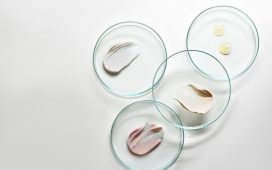Is sugar an essential ingredient in baking? What substitutes can I use, or can I simply just cut back on the quantity?
Alex, Bath
It’s first worth understanding what role the sweet stuff plays in bakes, Alex, and few are more clued up on the subject than Nicola Lamb, pastry chef and co-owner of pop-up bakery Puff. “Baking is a team effort of all the ingredients, and sugar is a big player,” she says, citing moisture, texture, caramelisation, flavour and longevity among its attributes.
In the name of research, Lamb baked three sponges: one using the sugar quantity specified in a recipe, the second using half and the third using none. The result? The sugarless cake was dense, pale and dry (“People would still believe it was a cake, just not a very good one”), while half measures made a crumb that was soft but dense, and tasted “OK”. So, in short: yes, you can mess around with the sugar in cakes, but accept that the taste and texture won’t be the same. “You just have to make that deal with yourself,” Lamb adds.
There’s no getting away from the fact that sugar substitutes require experimentation. Fruit is a popular option, because of its natural sugars, although Jerrelle Guy, author of Black Girl Baking, wouldn’t swap like for like because “their properties are very different”. Instead, use fruit (or veg) as a foil for adding less sugar to quick breads, cakes and brownies, or things that call for “fudginess and moisture”. Muffins are another good starting point, says Feast regular Benjamina Ebuehi, author of The New Way to Cake: “They’re quite forgiving, so start by removing 20-25% of the sugar, add a little apple sauce and see what that does.” Then, up the apple: “Try different percentages until you find your sweet spot.”
Dates are another option: Lamb boils them until tender, then blitzes and adds to banana bread or chocolate cake. In her book Baking with Less Sugar, Boston baker Joanne Chang soaks hers with a little baking soda to “break down the sometimes leathery skin”, before adding to shortbread (nine to 12 dates for 12 biscuits).
Chang is also a fan of fruit juice in pound cakes, sorbets and ice-creams. In her carrot-pineapple cake recipe, she simmers 335ml apple juice and the juice from a 225g tin of pineapple chunks for 20-25 minutes, until reduced to 180ml. She then whisks this into the wet ingredients, before folding in the dry.
Then there are syrups, honey, molasses and unrefined sugars, such as coconut, to play with. This route isn’t plain sailing, either, especially when liquids are involved. “You can’t subtract one thing without throwing off the rest of the equation,” Guy says. “If the sugar is just adding flavour [rather than tenderness, structure, aeration, etc], then maybe swap in maple syrup or honey.” You could do this for custard, too, “but use at least 25% less volume, or you could make it excessively sweet”.
As in life, it’s all about priorities. Lamb takes the “sugar hit” when it comes to her favourite bakes, and looks to cut down elsewhere: “A great mascarpone with some roast fruit can also be a satisfying dessert.”
• Do you have a culinary dilemma? Email feast@theguardian.com













